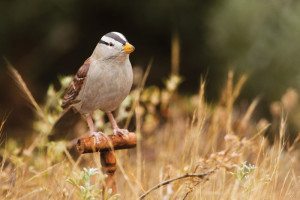SF sparrows adapt their song to urban noise
Editor’s: This article is excerpted from the latest issue of Bay Nature magazine. To read the complete article, click here.
By Kim Todd
Lobos Creek trailhead in the Presidio looks wild. Flushed orange monkey flower, sage, and coyote bush spill over re-created sand dunes. Nearby, the creek empties into the ocean. But close your eyes. A water truck pulls up to a stop sign with a mechanical whine. Car engines growl, foghorns moan, a distant airplane whirs. The noise, which never stops even though it’s barely 7 a.m., makes it clear you’re in the middle of the city.
In the parking lot, a white-crowned sparrow perches at the top of an evergreen tree next to a pickup truck and sings, launching a quick patter: whistle, buzz, two-part trill, and a scattering of notes. It’s music familiar to city dwellers, even if they couldn’t name it. The song is key to the white crown’s survival, helping him attract a mate and defend the territory around his nest, warning off other males with his vocal vigor. But the notes are almost drowned out as a bus sighs to a halt. Thanks to recent restoration efforts, the bird is surrounded by plants, such as lupine, that evolved here over centuries, along with the sparrow. But there is no restoring the silence, and the noise grows year by year. What will it take for white crowns like this one to survive in this new soundscape? What will it take to be heard?

Down the boardwalk, David Luther, a quiet-voiced, rusty-haired biologist from George Mason University in Virginia, is trying to find out.
“In the past ten years or so, there has been mounting evidence of how human noise is affecting these birds,” says Luther. Not just birds, he adds, but other animals, too. Studies in the developing field of “acoustic ecology” show whales, crickets, and frogs altering their behavior in response to man-made sounds. While some flee the cacophony, others adjust their internal clocks. Along a river near the Madrid airport, nightingales and European goldfinches sing earlier in the morning before the roar of the planes starts up. In Sheffield, England, robin redbreasts in noise-cluttered areas have started to sing at night. The whole “dawn chorus” has moved away from dawn. And others, like the white-crowned sparrows, are changing their tunes.
Bay Area white-crowned sparrows are famous in ornithological circles for their flexible songs. Like many songbirds, white crowns develop dialects specific to certain areas, the way a California drawl in Humboldt County differs from one in Los Angeles. But their dialects are so distinct, the boundaries so sharp, they have become a subject of choice for researchers studying song learning and evolution. As early as the 1960s, researchers found that San Francisco resident white crowns sound markedly different from those in Marin, just a few miles away. In the East Bay, white crowns in Tilden Park sang different songs than those in Richmond or ones that lived by the Bancroft Library, replacing a trill with a buzz, or swapping out a jumble of whistles. Scientists charted ten dialects in parts of the Bay Area and tracked patterns shifting as a bird became bilingual or a migrant singing a new variation passed through.

But now a new pattern is being carved out. As Luther props up a wooden sparrow on a stick near a saddle between sand dunes, at a spot where a male guards a nest, he is taking 50 years of white-crowned sparrow studies in a fresh direction, gauging the impact of the increasingly noisy city on bird songs.

There’s no doubt they are changing. Luther and his colleagues have documented that these Presidio birds have clearly shifted to a dialect more audible above the urban din. And they sing even that dialect at a higher minimum frequency than in past decades, likely in an effort to rise above the low-frequency rumble of cars. Now the researchers want to understand how the birds made that change, and more important, at what cost, catching a glimpse of the future of the song, and the bird, and the nature of the city.
“What are the potentially evolutionary effects?” he asks, setting up a speaker in the male’s territory. He’s preparing to play a rival’s song, either a traditional one or one at an even higher minimum frequency, and take notes on the white crown’s response. “Do the birds care, and how do they care?”
Luther sits in the dirt, presses Play, and waits.
(To read the rest of this article, including a number of very cool audio files and maps of White-crowned Sparrow song in different neighborhoods of San Francisco, please see the Bay Nature web site.)


